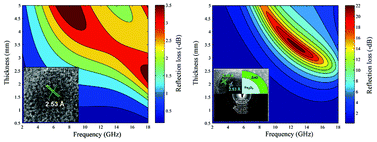Enhanced microwave absorption of Fe3O4nanocrystals after heterogeneously growing with ZnO nanoshell
Abstract
To enhance the microwave absorption of Fe3O4

* Corresponding authors
a
School of Chemical Engineering and Technology, Harbin Institute of Technology, Harbin 150001, P. R. China
E-mail:
wangzhijiang@hit.edu.cn, jiangzhaohua@hit.edu.cn
b Department of Medical Imaging and Nuclear Medicine, the 4th Affiliated Hospital, Harbin Medical University, Harbin, 150001, P. R. China
c Canadian Light Source Inc., Saskatoon, Saskatchewan, S7N 0X4, Canada
To enhance the microwave absorption of Fe3O4

 Please wait while we load your content...
Something went wrong. Try again?
Please wait while we load your content...
Something went wrong. Try again?
Z. Wang, L. Wu, J. Zhou, B. Shen and Z. Jiang, RSC Adv., 2013, 3, 3309 DOI: 10.1039/C2RA23404A
To request permission to reproduce material from this article, please go to the Copyright Clearance Center request page.
If you are an author contributing to an RSC publication, you do not need to request permission provided correct acknowledgement is given.
If you are the author of this article, you do not need to request permission to reproduce figures and diagrams provided correct acknowledgement is given. If you want to reproduce the whole article in a third-party publication (excluding your thesis/dissertation for which permission is not required) please go to the Copyright Clearance Center request page.
Read more about how to correctly acknowledge RSC content.
 Fetching data from CrossRef.
Fetching data from CrossRef.
This may take some time to load.
Loading related content
